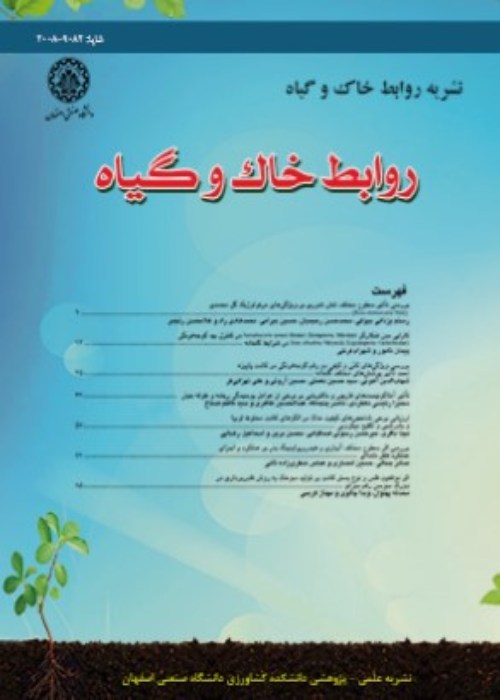Determining The Minimum Number of Soil Samples for Soil and Plant Interactions Studies (A Case Study in Salsola spp. Habitats in Three Dry Regions of Iran)
A review of research on soil and plant interactions in rangeland and desert ecosystems shows that the number of soil samples are not determined on a scientific basis. The present study, with the aim of using effect size and power analysis to determine the number of soil samples in three plant types of Salsola spp. was conducted in three arid and semiarid regions of Shahriar, Zirkouh and Zabol. In addition, 15, 10, and 5 soil samples were collected for each plant type, respectively. Some soil properties, including electrical conductivity, sand content, organic matter content, calcium carbonate equivalent, and saturation percentage, were determined in the laboratory. The number of samples was estimated after the initial sampling based on the calculated effect size (f) and the power of 80 % and before the sampling based on the medium effect size (f = 0.25) and the power of 60 %. The results showed that the power analysis of the three studied sites was 88, 56, and 38 %, respectively. To determine the minimum number of soil samples required to achieve a power of 80 %, at least 20 soil samples are required for Zabol and Zirkouh, and at least 12 soil samples are required for Shahriar. If there is no previous information about the soil properties, more than 50 soil samples must be collected from each plant type for a statistical comparison of three plant types with a medium effect size, a power of 80 %, and a significant level of 0.05.
In the field of vegetation studies, there are statistical and graphical methods to estimate the number of plots needed for sampling, and their application has been approved in numerous research studies. In a review of research on soil and plant interactions in rangeland and desert ecosystems, it seems that the number of soil samples are not determined based on a scientific basis. Either by autecology or synecology, soil samples were taken from different depths at the first and end points of each transect according to the soil depth by using the random-systematic method (i.e., a total of 6–8 soil samples). The sampling scheme captures all the decisions and information, such as the purpose of the sampling, financial constraints, sampling method, sample size, method(s) of statistical analysis, and accuracy of results (Arzani and Abedi, 2015). One of the most frequent problems in statistical analysis is determining the appropriate sample size (Rostampour and Eftekhari, 2023). The present study has the aim of using effect size and power analysis to determine the number of soil samples in three plant types in the halophyte-psammophyte ecosystem of the arid and semi-arid regions.
The present study was conducted on three plant types of Salsola spp. in three arid and desert areas of Shahriar, Zirkouh, and Zabol. At Shahriar, Zirkouh and Zabol sites, 15, 10, and 5 soil samples were collected for each plant type, respectively. Then, the soil samples were passed through a 2-mm sieve and some soil properties, including electrical conductivity, organic matter content, sand content, calcium carbonate equivalent and saturation percentage were measured in the laboratory. In general, for estimating the number of samples based on power analysis, there is a need for three factors: effect size, power, and significant levels. In the present study, two methods were used to determine the number of soil samples: 1) the estimation of the optimal sample number after the initial sampling based on the calculated effect size (f) and the power of 80 %, and 2) the minimum number of samples before sampling based on the medium effect size (f = 0.25) and power of 60 %.
The results showed that with an increase in the number of soil samples, the power analysis of the three studied sites was 38, 56, and 88 %, respectively. To determine the minimum number of soil samples required to achieve a power of 80 %, at least 20 soil samples are required for the Zabol and Zirkouh sites, and at least 12 soil samples are required for the Shahriar site. If the effect size is unknown due to the absence of data variance, the numbers of samples required for the sample sizes of small, medium, and large, and to reach a power of 60 % at the level of 0.05, are about 209, 35, and 14 samples, respectively. If there is no previous information about the soil properties, for a statistical comparison of three plant types with a medium effect size, a power of 80 %, and a significant level of 0.05, more than 50 soil samples must be collected from each plant type.
As per guideline, a power of 80 % is often considered an acceptable threshold, and studies with a power of less than 50 % should not be usually conducted. Accordingly, only the Shahriar site has a power above 60 %. Therefore, sampling from the Zirkouh and Zabol sites was not adequate for the statistical analysis. If there is no previous information about the soil properties, at least 50 soil samples should be collected from each plant type to compare the statistical significance of the three plant types with a medium effect size (F = 0.25) and a significant level of 0.05.
- حق عضویت دریافتی صرف حمایت از نشریات عضو و نگهداری، تکمیل و توسعه مگیران میشود.
- پرداخت حق اشتراک و دانلود مقالات اجازه بازنشر آن در سایر رسانههای چاپی و دیجیتال را به کاربر نمیدهد.


